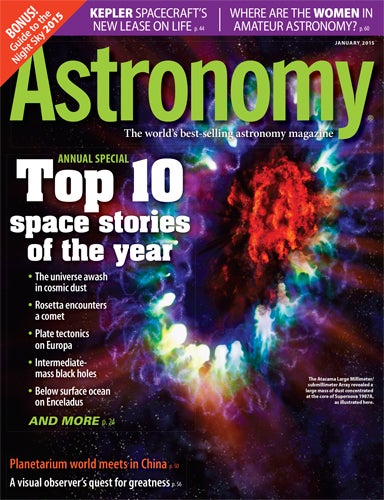
Astronomy offers you the most exciting, visually stunning, thorough, and timely coverage of the heavens above. Each monthly issue includes expert science reporting, vivid color photography, complete sky-event coverage, spot-on observing tips, informative equipment reviews, and more. All of this comes in an easy-to-understand user-friendly style that’s perfect for astronomers at any level. Contact Astronomy, the world’s best-selling astronomy magazine, at 262.796.8776 or email editor@astronomy.com.
WAUKESHA, Wis. – Every day, the editors of Astronomy have the privilege of learning what scientists are uncovering about the universe. With sophisticated instruments scouring the skies from Earth’s surface and space, it’s no surprise that 2014 saw dozens of major astronomical discoveries.
Planetary science had an especially strong showing, with further research on Saturn’s moon Enceladus, Jupiter’s moon Europa, many smaller solar system bodies, and objects beyond Pluto’s orbit. Cosmology had an exciting year as well, including a much debated possible confirmation of a period of hyperacceleration in the early cosmos – the inflationary epoch. Plus astronomers made an impressively accurate measurement of a million distant galaxies. But what was the biggest story of the year?
Astronomy‘s editors ranked the most important stories of the past 12 months, and Contributing Editor Liz Kruesi highlights those discoveries in “Top 10 space stories of 2014.”
Read the countdown in the January 2015 issue of Astronomy magazine, on newsstands December 2.
“Kepler spacecraft’s new lease on life”
Timing couldn’t have been any stranger for exoplanet-hunting Kepler scientists. Just two days after their spacecraft’s four-year milestone, the amount of time engineers had essentially guaranteed a working space telescope, Kepler’s second of four reaction wheels failed. Without three working gyroscopes, the space telescope’s pointing accuracy – vital to finding exoplanet candidates – was caput. But the Kepler team didn’t give up. In “Kepler spacecraft’s new lease on life,” C. Renée James details the novel solution engineers came up with to continue using the spacecraft and the science astronomers hope to accomplish with the new K2 mission.
“Where are the women in amateur astronomy?”
“Are you here with your husband?” It’s a question most women hear at some point during any major star party. And it’s unfortunately the case because there are relatively few women active in amateur astronomy, which makes each one somewhat of a surprise to male observers and astroimagers. In “Where are the women in amateur astronomy?” Astronomy Foundation Vice President Karen Jennings attempts to shed some light on the question and introduces a handful of female role models for stargazing women and girls everywhere.
“10 top winter binocular treats”
There are more spectacular targets to see through binoculars in winter than probably any other season. But what about some less obvious objects that often go overlooked? In “10 top winter binocular treats,” Contributing Editor Phil Harrington focuses on some tougher targets through lower-power optics, including the California Nebula (NGC 1499) and the 37 Cluster (NGC 2169).
January sky events visible without optical aid
- January 3 – The Quadrantid meteor shower peaks.
- January 14 – Mercury and Venus make a fine duo at dusk.
- January 16 – Saturn shines near a crescent Moon before dawn.
Also in the December 2014 Astronomy
- “The planetarium world meets in China”: As dark skies diminish, the International Planetarium Society meets in Beijing to discuss its members’ greater responsibility in bringing the stars down to Earth.
- “A visual observer’s quest for greatness”: With more than 1,000 sketches of deep-sky objects to his credit, Roger Ivester still just wants to observe.
- “Astronomy‘s 2015 Guide to the Night Sky”: This handy four-page insert will keep you looking up all year.
- “The Sky this Month”: Exclusive star charts will guide you through January’s night sky.
- The January issue also features Snapshot, Breakthrough, Astro News, Ask Astro, Bob Berman’s Strange Universe, Glenn Chaple’s Observing Basics, Stephen James O’Meara’s Secret Sky, Adam Block’s Cosmic Imaging, Astro Sketching, New Products, Letters, Web Talk, Reader Gallery, and Final Frontier.









